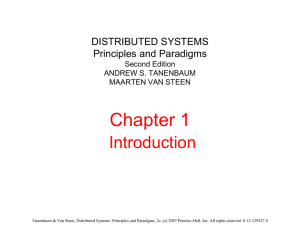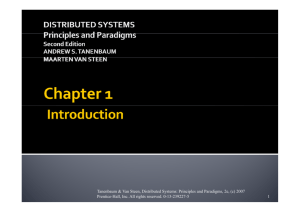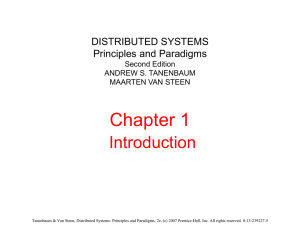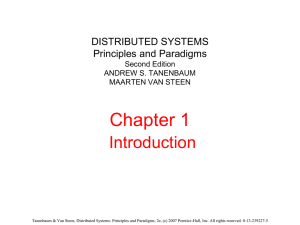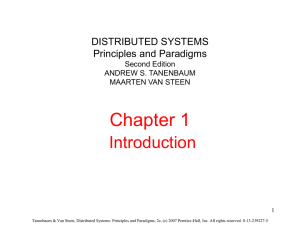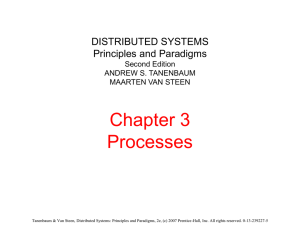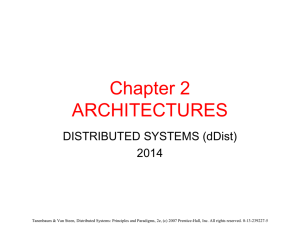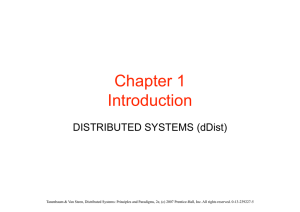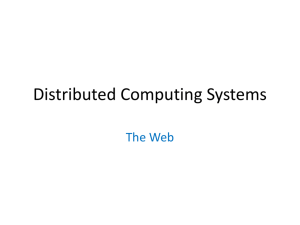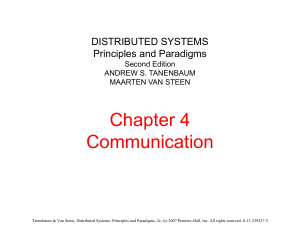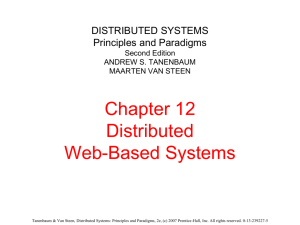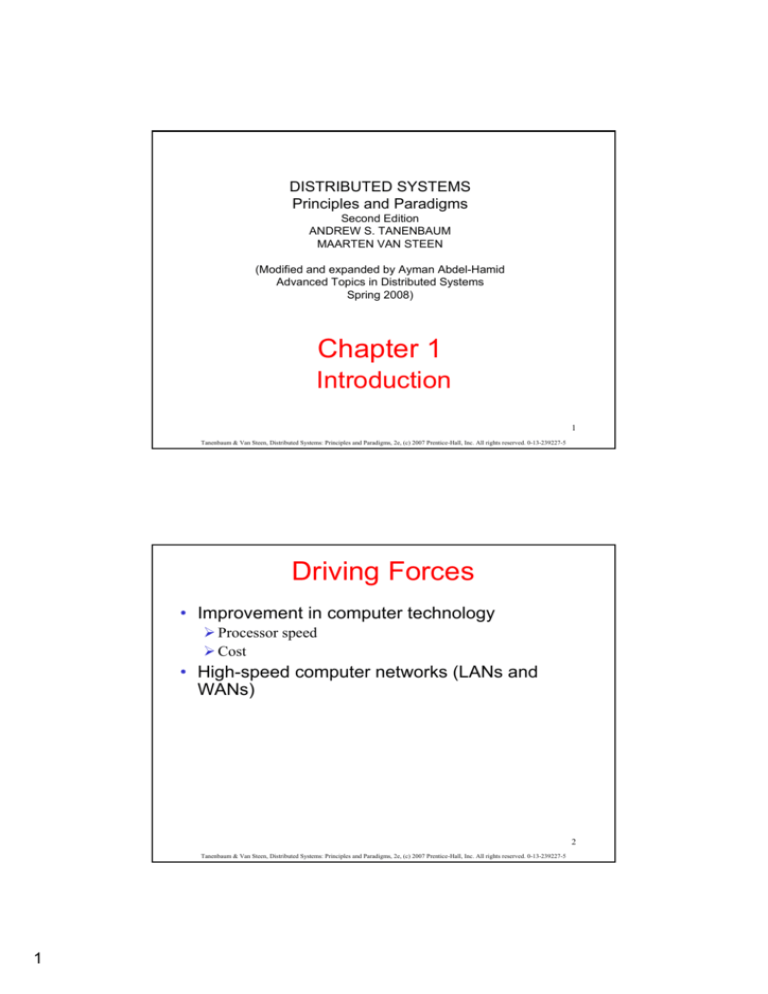
DISTRIBUTED SYSTEMS
Principles and Paradigms
Second Edition
ANDREW S. TANENBAUM
MAARTEN VAN STEEN
(Modified and expanded by Ayman Abdel-Hamid
Advanced Topics in Distributed Systems
Spring 2008)
Chapter 1
Introduction
1
Tanenbaum & Van Steen, Distributed Systems: Principles and Paradigms, 2e, (c) 2007 Prentice-Hall, Inc. All rights reserved. 0-13-239227-5
Driving Forces
• Improvement in computer technology
¾ Processor speed
¾ Cost
• High-speed computer networks (LANs and
WANs)
2
Tanenbaum & Van Steen, Distributed Systems: Principles and Paradigms, 2e, (c) 2007 Prentice-Hall, Inc. All rights reserved. 0-13-239227-5
1
Definition of a Distributed System (1)
• A distributed system is:
A collection of independent computers that
appears to its users as a single coherent system
• Characteristics
¾ Heterogeneity hidden from users
¾ Consistent, uniform interaction regardless of location and
time
¾ Expandable and scalable
¾ Availability
• Examples of distributed systems
3
Tanenbaum & Van Steen, Distributed Systems: Principles and Paradigms, 2e, (c) 2007 Prentice-Hall, Inc. All rights reserved. 0-13-239227-5
Definition of a Distributed System (2)
Figure 1-1. A distributed system organized as middleware. The
middleware layer extends over multiple machines, and offers
each application the same interface.
4
Tanenbaum & Van Steen, Distributed Systems: Principles and Paradigms, 2e, (c) 2007 Prentice-Hall, Inc. All rights reserved. 0-13-239227-5
2
Goals
• Connecting users and resources
¾ Remote resources, sharing, and security
• Transparency
¾ Hide the distributed nature of the system
¾ Implications on performance
• Openness
¾ Offers services according to standard rules that describe syntax and semantics of
services
¾ Interfaces and IDL (completeness and neutrality Æ Interoperability and
portability)
¾ Flexibility Æ Separating policy from mechanism
• Scalability
¾ Size (more users and resources)
¾ Geographical scalability (communication in LANs (synchronous) versus WANs)
¾ Administrative scalability (conflicting policies across domains)
5
Tanenbaum & Van Steen, Distributed Systems: Principles and Paradigms, 2e, (c) 2007 Prentice-Hall, Inc. All rights reserved. 0-13-239227-5
Transparency in a Distributed System
Figure 1-2. Different forms of transparency in a
distributed system (ISO, 1995).
6
Tanenbaum & Van Steen, Distributed Systems: Principles and Paradigms, 2e, (c) 2007 Prentice-Hall, Inc. All rights reserved. 0-13-239227-5
3
Scalability Problems
Figure 1-3. Examples of scalability limitations.
7
Tanenbaum & Van Steen, Distributed Systems: Principles and Paradigms, 2e, (c) 2007 Prentice-Hall, Inc. All rights reserved. 0-13-239227-5
Scalability Problems
Characteristics of decentralized algorithms:
• No machine has complete information about the
system state.
• Machines make decisions based only on local
information.
• Failure of one machine does not ruin the
algorithm.
• There is no implicit assumption that a global
clock exists.
8
Tanenbaum & Van Steen, Distributed Systems: Principles and Paradigms, 2e, (c) 2007 Prentice-Hall, Inc. All rights reserved. 0-13-239227-5
4
Scaling Techniques 1/3
•
Hiding communication latencies
¾ Asynchronous communication
¾ Interactive applications? (push front-end processing to
client)
•
Distribution
¾ DNS
¾ WWW
•
Replication
¾ Availability and load balancing
¾ Consistency problems
9
Tanenbaum & Van Steen, Distributed Systems: Principles and Paradigms, 2e, (c) 2007 Prentice-Hall, Inc. All rights reserved. 0-13-239227-5
Scaling Techniques 2/3
Figure 1-4. The difference between letting (a) a server
or (b) a client check forms as they are being filled.
10
Tanenbaum & Van Steen, Distributed Systems: Principles and Paradigms, 2e, (c) 2007 Prentice-Hall, Inc. All rights reserved. 0-13-239227-5
5
Scaling Techniques 3/3
Figure 1-5. An example of dividing the DNS
name space into zones.
11
Tanenbaum & Van Steen, Distributed Systems: Principles and Paradigms, 2e, (c) 2007 Prentice-Hall, Inc. All rights reserved. 0-13-239227-5
Pitfalls when Developing
Distributed Systems
False assumptions made by first time developer:
• The network is reliable.
• The network is secure.
• The network is homogeneous.
• The topology does not change.
• Latency is zero.
• Bandwidth is infinite.
• Transport cost is zero.
• There is one administrator.
12
Tanenbaum & Van Steen, Distributed Systems: Principles and Paradigms, 2e, (c) 2007 Prentice-Hall, Inc. All rights reserved. 0-13-239227-5
6
Software Concepts
System
Description
Main Goal
DOS
Tightly-coupled operating system for
multiprocessors and homogeneous
multicomputers
Hide and manage
hardware resources
NOS
Loosely-coupled operating system for
heterogeneous multicomputers (LAN and
WAN)
Offer local services
to remote clients
Middleware
Additional layer atop of NOS implementing
general-purpose services
Provide distribution
transparency
13
Tanenbaum & Van Steen, Distributed Systems: Principles and Paradigms, 2e, (c) 2007 Prentice-Hall, Inc. All rights reserved. 0-13-239227-5
Multicomputer Operating Systems
14
Tanenbaum & Van Steen, Distributed Systems: Principles and Paradigms, 2e, (c) 2007 Prentice-Hall, Inc. All rights reserved. 0-13-239227-5
7
Network Operating System
15
Tanenbaum & Van Steen, Distributed Systems: Principles and Paradigms, 2e, (c) 2007 Prentice-Hall, Inc. All rights reserved. 0-13-239227-5
Distributed System as Middleware
•Scalability and openness of NOS
•Transparency of DOS
•Mask heterogeneity of lower levels
16
Tanenbaum & Van Steen, Distributed Systems: Principles and Paradigms, 2e, (c) 2007 Prentice-Hall, Inc. All rights reserved. 0-13-239227-5
8
Middleware Services
•
•
•
•
•
•
High-level communication facilities
Transparent access to remote data
Naming (sharing and look up)
Persistence
Distributed transactions
Security
17
Tanenbaum & Van Steen, Distributed Systems: Principles and Paradigms, 2e, (c) 2007 Prentice-Hall, Inc. All rights reserved. 0-13-239227-5
Middleware and Openness
In an open middleware-based distributed system,
the protocols used by each middleware layer should
be the same, as well as the interfaces they offer to
applications.
18
Tanenbaum & Van Steen, Distributed Systems: Principles and Paradigms, 2e, (c) 2007 Prentice-Hall, Inc. All rights reserved. 0-13-239227-5
9

